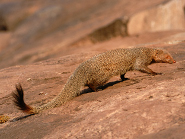 The ruddy mongoose (Herpestes smithii) lives in India and Sri Lanka, being the only type of mongoose found in these regions. It very close related to the Indian grey mongoose. Other species of mongoose can be found throughout South Asia and Africa, with a total of 33 different mongoose species in all. The ruddy mongoose are usually found in hills and forests, generally preferring to hide. The life expectancy of the ruddy mongoose isn't known, but generally, the mongoose has been known to live anywhere between 7 and 13 years of age. It would be safe to assume the ruddy mongoose would rank in the lower to mid part of that range, being it's among the smaller species.
The ruddy mongoose (Herpestes smithii) lives in India and Sri Lanka, being the only type of mongoose found in these regions. It very close related to the Indian grey mongoose. Other species of mongoose can be found throughout South Asia and Africa, with a total of 33 different mongoose species in all. The ruddy mongoose are usually found in hills and forests, generally preferring to hide. The life expectancy of the ruddy mongoose isn't known, but generally, the mongoose has been known to live anywhere between 7 and 13 years of age. It would be safe to assume the ruddy mongoose would rank in the lower to mid part of that range, being it's among the smaller species.At its full size, its body can reach between 39 and 47 centimeters, or 15.3 and 18.6 inches, with its tail being between 33 and 36 centimeters, or 13 and 14.2 inches. The mongoose is a light animal, weighing only around 0.95 and 1.85 kgs, or 2 and 4 pounds. Their coat is usually brown, with white and black specks peppering throughout its body. The mongoose head blends into a reddish color, with the tip of its tail being painted black.
The ruddy mongoose is not endangered in the least, and often mongoose are kept as pets.
Not much is known about the ruddy mongoose's behavior, except that it is a feisty little animal. This mongoose can attack and kill a cobra, one of the most deadly snake there are, without being harmed at all. By bristling its fur, it can appear to be much larger than it really is, making its predators afraid and put off guard. Snakes, small lizards, rodents, and dead carcasses are among the ruddy mongoose's diet.
Picture of the Ruddy mongoose from Daroji wildlife sanctuary in Karnataka, India, by Kalyanvarma, licensed under the Creative Commons Attribution-Share Alike 3.0 Unported license.
The Ruddy mongoose is listed as Least Concern (LR/lc), lowest risk. Does not qualify for a more at risk category. Widespread and abundant taxa are included in this category, on the IUCN Red List of Threatened Species
Namings for the ruddy mongoose
A ruddy mongoose group is called a 'mongeese or mongaggle'.
Custom Search